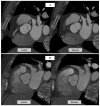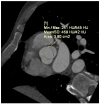Aortic Valve Calcium Score: Applications in Clinical Practice and Scientific Research-A Narrative Review
- PMID: 39064103
- PMCID: PMC11277735
- DOI: 10.3390/jcm13144064
Aortic Valve Calcium Score: Applications in Clinical Practice and Scientific Research-A Narrative Review
Abstract
In this narrative review, we investigate the essential role played by the computed tomography Aortic Valve Calcium Score (AVCS) in the cardiovascular diagnostic landscape, with a special focus on its implications for clinical practice and scientific research. Calcific aortic valve stenosis is the most prevalent type of aortic stenosis (AS) in industrialized countries, and due to the aging population, its prevalence is increasing. While transthoracic echocardiography (TTE) remains the gold standard, AVCS stands out as an essential complementary tool in evaluating patients with AS. The advantage of AVCS is its independence from flow; this allows for a more precise evaluation of patients with discordant findings in TTE. Further clinical applications of AVCS include in the assessment of patients before transcatheter aortic valve replacement (TAVR), as it helps in predicting outcomes and provides prognostic information post-TAVR. Additionally, we describe different AVCS thresholds regarding gender and the anatomical variations of the aortic valve. Finally, we discuss various scientific studies where AVCS was applied. As AVCS has some limitations, due to the pathophysiologies of AS extending beyond calcification and gender differences, scientists strive to validate contrast-enhanced AVCS. Furthermore, research on developing radiation-free methods of measuring calcium content is ongoing.
Keywords: AVC; CT-AVC; aortic valve calcification score; aortic valve stenosis; artificial intelligence; bicuspid; calcium scoring; echocardiography; multidetector computed tomography.
Conflict of interest statement
The authors declare no conflicts of interest.
Figures




Similar articles
-
Identifying fragile calcifications of the aortic valve in transcatheter aortic valve replacement: iodine concentration of aortic valvular calcification by spectral CT.Eur Radiol. 2023 Mar;33(3):1963-1972. doi: 10.1007/s00330-022-09133-3. Epub 2022 Sep 16. Eur Radiol. 2023. PMID: 36112191
-
Doppler Mean Gradient Is Discordant to Aortic Valve Calcium Scores in Patients with Atrial Fibrillation Undergoing Transcatheter Aortic Valve Replacement.J Am Soc Echocardiogr. 2022 Jan;35(1):116-123. doi: 10.1016/j.echo.2021.08.024. Epub 2021 Sep 8. J Am Soc Echocardiogr. 2022. PMID: 34506919
-
Severe aortic stenosis with low aortic valve calcification: characteristics and outcome following transcatheter aortic valve implantation.Eur Heart J Cardiovasc Imaging. 2017 Jun 1;18(6):639-647. doi: 10.1093/ehjci/jex006. Eur Heart J Cardiovasc Imaging. 2017. PMID: 28369223
-
Aortic Valve Calcium: A Narrative Review of its Role in the Assessment of Aortic Stenosis and as a Predictor of Post-transcatheter Aortic Valve Implantation Outcomes.Interv Cardiol. 2025 May 2;20:e16. doi: 10.15420/icr.2024.17. eCollection 2025. Interv Cardiol. 2025. PMID: 40396184 Free PMC article. Review.
-
Why and How to Measure Aortic Valve Calcification in Patients With Aortic Stenosis.JACC Cardiovasc Imaging. 2019 Sep;12(9):1835-1848. doi: 10.1016/j.jcmg.2019.01.045. JACC Cardiovasc Imaging. 2019. PMID: 31488252 Review.
Cited by
-
Increased Left Ventricular Myocardial Extracellular Volume Assessed by Cardiac Computed Tomography as a Consequence of Aortic Stenosis and Coexisting Cardiovascular Risk Factors.J Clin Med. 2025 Jun 22;14(13):4435. doi: 10.3390/jcm14134435. J Clin Med. 2025. PMID: 40648809 Free PMC article.
References
-
- Amoakwa K., Fashanu O.E., Tibuakuu M., Zhao D., Guallar E., Whelton S.P., O’Neal W.T., Post W.S., Budoff M.J., Michos E.D. Resting heart rate and the incidence and progression of valvular calcium: The Multi-Ethnic Study of Atherosclerosis (MESA) Atherosclerosis. 2018;273:45–52. doi: 10.1016/j.atherosclerosis.2018.04.004. - DOI - PMC - PubMed
-
- Messika-Zeitoun D., Bielak L.F., Peyser P.A., Sheedy P.F., Turner S.T., Nkomo V.T., Breen J.F., Maalouf J., Scott C., Tajik A.J., et al. Aortic valve calcification: Determinants and progression in the population. Arterioscler. Thromb. Vasc. Biol. 2007;27:642–648. doi: 10.1161/01.ATV.0000255952.47980.c2. - DOI - PubMed
Publication types
LinkOut - more resources
Full Text Sources
Research Materials

